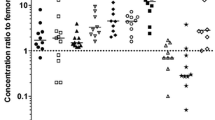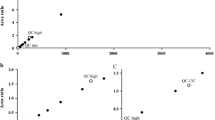Abstract
The postmortem redistribution (PMR) phenomenon complicates interpretation in forensic toxicology. Human data on time-dependent PMR are rare and only exist for blood so far. A new method for investigation of time-dependent PMR in blood as well as in alternative body fluids and tissues was developed and evaluated using automated biopsy sampling. At admission of the bodies, introducer needles were placed in liver, lung, kidney, muscle, spleen, adipose tissue, heart, femoral vein, and lumbar spine using a robotic arm guided by a computed tomography scanner (CT). Needle placement accuracy was analyzed and found to be acceptable for the study purpose. Tissue biopsies and small volume body fluid samples were collected in triplicate through the introducer needles. At autopsy (around 24 h after admission), samples from the same body regions were collected. After mastering of the technical challenges, two authentic cases were analyzed as a proof of concept. Drug concentrations of venlafaxine, O-desmethylvenlafaxine, bromazepam, flupentixol, paroxetine, and lorazepam were determined by LC-MS/MS, and the percentage concentration changes between the two time points were calculated. Concentration changes were observed with both increases and decreases depending on analyte and matrix. While venlafaxine, flupentixol, paroxetine, and lorazepam generally showed changes above 30 % and more, O-desmethylvenlafaxine and bromazepam did not undergo extensive PMR. The presented study shows that CT-controlled biopsy collection provides a valuable tool for systematic time-dependent PMR investigation, demanding only minimal sample amount and causing minimal damage to the body.

New strategy for time-dependent postmortem redistribution studies by CT guided biopsy sampling prior to autopsy and comparison of drug concentrations at these two time points using validated LC-MS/MS quantitation.





Similar content being viewed by others
References
Pelissier-Alicot AL, Gaulier JM, Champsaur P, Marquet P. Mechanisms underlying postmortem redistribution of drugs: a review. J Anal Toxicol. 2003;27(8):533–44.
Skopp G. Postmortem toxicology. Forensic Sci Med Pathol. 2010;6(4):314–25.
Yarema MC, Becker CE. Key concepts in postmortem drug redistribution. Clintoxicol. 2005;43(4):235–41.
Prouty RW, Anderson WH. The forensic science implications of site and temporal influences on postmortem blood-drug concentrations. J Forensic Sci. 1990;35(2):243–70.
Pounder DJ, Adams E, Fuke C, Langford AM. Site to site variability of postmortem drug concentrations in liver and lung. J Forensic Sci. 1996;41(6):927–32.
Leikin JB, Watson WA. Post-mortem toxicology: what the dead can and cannot tell us. J ToxicolClin Toxicol. 2003;41(1):47–56.
Hilberg T, Rogde S, Morland J. Postmortem drug redistribution—human cases related to results in experimental animals. J Forensic Sci. 1999;44(1):3–9.
Han E, Kim E, Hong H, Jeong S, Kim J, In S, et al. Evaluation of postmortem redistribution phenomena for commonly encountered drugs. Forensic Sci Int. 2012;219(1–3):265–71.
Jones GR, Pounder DJ. Site dependence of drug concentrations in postmortem blood—a case study. J Anal Toxicol. 1987;11(5):186–90.
Saar E, Beyer J, Gerostamoulos D, Drummer OH. The time-dependant post-mortem redistribution of antipsychotic drugs. Forensic Sci Int. 2012;222(1–3):223–7.
Gerostamoulos D, Beyer J, Staikos V, Tayler P, Woodford N, Drummer OH. The effect of the postmortem interval on the redistribution of drugs: a comparison of mortuary admission and autopsy blood specimens. Forensic Sci Med Pathol. 2012;8(4):373–9.
Robertson MD, Drummer OH. Postmortem distribution and redistribution of nitrobenzodiazepines in man. J Forensic Sci. 1998;43(1):9–13.
Martin A, Pounder DJ. Post-mortem toxico-kinetics of trazodone. Forensic Sci Int. 1992;56(2):201–7.
Yonemitsu K, Pounder DJ. Postmortem changes in blood tranylcypromine concentration: competing redistribution and degradation effects. Forensic Sci Int. 1993;59(2):177–84.
Gerostamoulos D, Drummer OH. Postmortem redistribution of morphine and its metabolites. J Forensic Sci. 2000;45(4):843–5.
Hargrove VM, Molina DK. Peripheral postmortem redistribution of morphine. Am J Forensic Med Pathol. 2014;35(2):106–8.
Logan BK, Smirnow D, Gullberg RG. Lack of predictable site-dependent differences and time-dependent changes in postmortem concentrations of cocaine, benzoylecgonine, and cocaethylene in humans. J Anal Toxicol. 1997;21(1):23–31.
Logan BK, Smirnow D. Postmortem distribution and redistribution of morphine in man. J Forensic Sci. 1996;41(2):221–9.
Quatrehomme G, Bourret F, Liao Z, Ollier A. An experimental methodology for the study of postmortem changes in toxic concentrations of drugs, using secobarbital as an example. J Forensic Sci. 1994;39(5):1300–4.
Brunet B, Hauet T, Hebrard W, Papet Y, Mauco G, Mura P. Postmortem redistribution of THC in the pig. Int J Legal Med. 2010;124(6):543–9.
Butzbach DM. The influence of putrefaction and sample storage on post-mortem toxicology results. Forensic Sci Med Pathol. 2010;6(1):35–45.
Skopp G. Preanalytic aspects in postmortem toxicology. Forensic Sci Int. 2004;142(2–3):75–100.
Cantrell FL, Ogera P, Mallett P, McIntyre IM. Fatal oral methylphenidate intoxication with postmortem concentrations. J Forensic Sci. 2014;59(3):847–9.
Levine B, Phipps RJ, Naso C, Fahie K, Fowler D. Tissue distribution of newer anticonvulsant drugs in postmortem cases. J Anal Toxicol. 2010;34(8):506–9.
Vermeulen T. Distribution of paroxetine in three postmortem cases. J Anal Toxicol. 1998;22(6):541–4.
Staeheli SN, Poetzsch M, Kraemer T, Steuer AE. Development and validation of a dynamic range-extended LC-MS/MS multi-analyte method for 11 different postmortem matrices for redistribution studies applying solvent calibration and additional (13)C isotope monitoring. Anal Bioanal Chem. 2015;407(29):8681–712.
Ebert LC, Ptacek W, Breitbeck R, Furst M, Kronreif G, Martinez RM, et al. Virtobot 2.0: the future of automated surface documentation and CT-guided needle placement in forensic medicine. Forensic Sci Med Pathol. 2014;10(2):179–86.
Langford AM, Taylor KK, Pounder DJ. Drug concentration in selected skeletal muscles. J Forensic Sci. 1998;43(1):22–7.
Rodda KE, Drummer OH. The redistribution of selected psychiatric drugs in post-mortem cases. Forensic Sci Int. 2006;164(2–3):235–9.
Dalpe-Scott M, Degouffe M, Garbutt D, Drost M. A comparison of drug concentrations in postmortem cardiac and peripheral blood in 320 cases. Can Soc Forensic Sci J. 1995;28(2):113–21.
Pos Pok PR, Haddouche D, Mauras M, Kuhlmann E, Burle J, Salmon T, et al. Cardiac and peripheral blood similarities in the comparison of nordiazepam and bromazepam blood concentrations. J Anal Toxicol. 2008;32(9):782–6.
Kupiec TC, Allen LV, Basmadjian GP, Canfield DV, Chaturvedi AK, Blank CL, Parker D Post mortem redistribution of paroxetine using the rat as a model. Presented at The American Academy of Forensic Sciences annual meeting San Francisco, California, USA (1998).
Baselt RC Disposition of toxic drugs and chemicals in man. 8th ed (2008).
Documed Kompendium Documed AG. www.compendium.ch (2015) Accessed 21.08.2015.
Acknowledgments
The authors would like to thank PD Dr. Frank T. Peters for the helpful discussion on statistical problems.
Author information
Authors and Affiliations
Corresponding author
Ethics declarations
Ethical approval was obtained by the cantonal ethics committee of Zurich, Switzerland (approval number 42.2005).
Conflicts of interest
The authors declare that they have no competing interests.
Rights and permissions
About this article
Cite this article
Staeheli, S.N., Gascho, D., Fornaro, J. et al. Development of CT-guided biopsy sampling for time-dependent postmortem redistribution investigations in blood and alternative matrices—proof of concept and application on two cases. Anal Bioanal Chem 408, 1249–1258 (2016). https://doi.org/10.1007/s00216-015-9234-9
Received:
Accepted:
Published:
Issue Date:
DOI: https://doi.org/10.1007/s00216-015-9234-9




